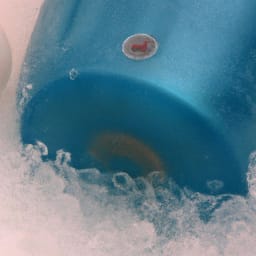Cold water immersion is a process of introducing the body to cold water to induce a variety of physical and physiological benefits. The first stage of cold water immersion is known as acclimatization. This process involves gradually exposing the body to cold temperatures in order to reduce the shock of sudden, extreme cold exposure. During this stage, the body becomes accustomed to the cold temperatures and can begin to reap the benefits of cold water immersion.Cold water immersion is a type of hydrotherapy that involves submerging the body in cold water. This process can be done in a pool, lake, or bathtub and typically lasts anywhere from 10 seconds to 10 minutes. During this time, the body is exposed to temperatures below 20°C (68°F). The cold temperatures cause vasoconstriction, which helps reduce inflammation and improve circulation. It can also stimulate the release of endorphins which can promote feelings of relaxation and improved mood. Cold water immersion is often used by athletes as part of their recovery routine after strenuous exercise or competition.
Stage One: Shock Response
When you first enter cold water, no matter how slowly, your body responds with a shock response. This is the body’s natural reaction to cold and is characterized by an involuntary gasp, increased heart rate and breathing rate, and an involuntary release of adrenaline. Your muscles also tense up in this stage as your body attempts to control its temperature.
Stage Two: Swimming Failure
At this stage, your breathing becomes more labored, and you may begin to feel lightheaded or faint. The strength of your swimming muscles starts to fail as well because of the cold temperature of the water. As a result, it will become difficult for you to swim or even hold onto something in the water.
Stage Three: Hypothermia
If you remain in cold water for too long without proper protection or rescue, your body will start to cool down rapidly. This can lead to hypothermia, which is when your core body temperature drops below 95 degrees Fahrenheit (35 degrees Celsius). Symptoms of hypothermia include shivering, confusion, slurred speech, loss of coordination and consciousness.
Stage Four: Exhaustion
At this stage, exhaustion sets in as your body tries to stay warm in the cold water by using up energy reserves at a rapid rate. Your movements become slower and more uncoordinated as your energy levels drop. You may also experience muscle cramps due to the cold temperatures and lack of oxygen in the water.
Stage Five: Unconsciousness
If left in cold water for too long without help or rescue, eventually you will lose consciousness from either exhaustion or hypothermia. At this point it is essential that you receive help immediately before it’s too late.
The First Stage of Cold Water Immersion
The first stage of cold water immersion is known as the ‘cold shock response’. This is the body’s initial reaction to sudden, unexpected cold water. It usually lasts from 30 to 90 seconds, and can include gasping for breath, an increase in heart rate, and a sudden decrease in blood pressure. The body’s natural instinct during this stage is to escape the cold environment as quickly as possible.
If a person remains submerged in cold water during this period, they will begin to experience an involuntary and uncontrollable rapid breathing called hyperventilation. This is the body’s response to the cold temperature and can be very dangerous if not controlled properly.
In addition to hyperventilation, other effects of cold shock response include increased blood flow towards the brain and vital organs, and a heightened state of alertness or panic. It is important for anyone entering cold water to remain calm and control their breathing during this stage. Doing so will help reduce the risk of drowning or other negative effects of cold shock response.
Cold Water Immersion
Cold water immersion is a practice that involves submerging your body in cold water for a period of time. It has been touted as a way to improve physical and mental health, as well as increase performance. While research into the benefits of cold water immersion is still ongoing, the evidence so far suggests that it can have real benefits for those who choose to take part.
Physical Benefits
One of the most widely accepted benefits of cold water immersion is its ability to reduce inflammation and provide relief from muscle soreness. This makes it an ideal choice for athletes looking to improve their performance or speed up recovery time after an intense workout. Cold water immersion has also been shown to reduce fatigue, decrease stress levels, and even help with weight loss by increasing metabolism.
Mental Benefits
In addition to its physical benefits, cold water immersion can also have positive effects on mental health. Research has found that exposure to cold water can reduce anxiety and depression, improve concentration and focus, and even boost creativity. It can also be used as a form of relaxation therapy, allowing people to destress and clear their minds from the worries of everyday life.
The Benefits of Cold Water Immersion
Overall, cold water immersion offers numerous physical and mental health benefits for those willing to take part in the practice. Its ability to reduce inflammation, improve performance, ease muscle soreness, reduce fatigue, decrease stress levels and boost creativity make it an ideal choice for athletes looking for an edge in their training or those simply seeking a way to relax and destress from daily life.
Physical Responses to Cold Water Immersion
Cold water immersion is a form of physical therapy which involves submerging oneself completely in cold water for a certain period of time. This type of therapy has a number of potential health benefits, including reducing inflammation and improving circulation. However, there are also some physical responses that occur when exposed to cold water. These responses can vary depending on the individual and their current state of health.
One of the most common physical responses to cold water immersion is shivering. Shivering is an involuntary response that is triggered when the body’s temperature drops below a certain level and is an attempt by the body to generate more heat. It can be quite uncomfortable, but it does serve an important purpose – it helps regulate the body’s temperature and prevent hypothermia from occurring.
Another physical response to cold water immersion is increased heart rate and blood pressure. As the body attempts to maintain its core temperature, it increases circulation in order to move warm blood closer to the skin’s surface. This increase in heart rate and blood pressure can cause lightheadedness or dizziness in some individuals, especially those with pre-existing conditions such as hypertension or cardiovascular disease.
Cold water immersion can also cause vasoconstriction, which is when the blood vessels constrict in order to reduce heat loss from the body. This vasoconstriction occurs mostly in extremities such as hands and feet and can cause them to feel numb or tingly. In addition, there may be an increase in muscle tension as well as an overall sense of discomfort due to exposure to cold temperatures for an extended period of time.
Finally, cold water immersion can also lead to increased breathing rate as well as increased production of sweat due to increased metabolism caused by the cold temperatures. It is important for individuals engaging in this type of therapy to make sure they are properly hydrated beforehand in order minimize any potential side effects related to dehydration or electrolyte imbalance caused by excessive sweating during their session.
Overall, there are a number of physical responses that occur when exposed to cold water immersion which can vary depending on the individual’s health status and condition at hand. It is important for individuals engaging in this type of therapy to be aware of these potential responses so they can take proper precautions beforehand if necessary

Psychological Effects of Cold Water Immersion
Cold water immersion is a therapeutic practice that has been used for centuries to promote physical and mental wellbeing. It has been known to help with stress, anxiety, depression, and insomnia. It can also be used to improve athletic performance and reduce muscle soreness after exercise. The psychological effects of cold water immersion are not well understood, but it is believed that the cold stimulates the body’s natural response to fear and discomfort, which can lead to a calming effect on the mind. Additionally, the sensation of being in cold water can be calming and can induce a meditative state.
The physical effects of cold water immersion are better known than its psychological effects. Cold water immersion causes vasoconstriction (narrowing of blood vessels) which reduces inflammation and increases blood flow throughout the body. This helps to reduce pain and improve recovery time after exercise or injury. Cold water immersion also stimulates the release of endorphins which are hormones that act as natural painkillers and can produce feelings of euphoria.
In addition to its physical benefits, cold water immersion may have some psychological benefits as well. Studies have found that being in cold water can increase resilience by improving one’s ability to cope with stress and adversity. It may also help reduce symptoms of depression by stimulating the release of neurotransmitters such as serotonin, dopamine, and norepinephrine which are associated with positive mood states. Cold water immersion is also thought to have an effect on cognitive functioning by improving focus and concentration due to its calming effect on the mind.
Overall, cold water immersion has both physical and psychological benefits that make it an effective therapy for a variety of conditions including stress, anxiety, depression, insomnia, muscle soreness after exercise, and cognitive functioning. While more research needs to be done in order to fully understand the psychological effects of cold water immersion, current evidence suggests that it is a safe and effective therapy for improving physical and mental wellbeing.
Preparing for Cold Water Immersion
Immersing oneself in cold water can provide a number of health benefits, including improved circulation, reduced stress, and increased energy. However, it is important to take the necessary precautions when engaging in cold water immersion. In order to maximize the potential benefits while avoiding potential risks, it is important to properly prepare for the experience.
The first step in preparing for cold water immersion is to ensure that the environment is safe and comfortable. It is important to find a body of water that is free from debris and other hazards. Additionally, it is important to check the temperature of the water before entering so that it does not become too cold or uncomfortable during the activity.
Next, it is important to dress appropriately for the activity. A wetsuit or other protective clothing should be worn when entering colder waters. It is also important to remain hydrated and wear sunscreen if one will be exposed to direct sunlight. Additionally, it is also beneficial to use earplugs or other protective gear if necessary.
Finally, it is important to gradually acclimate oneself to colder temperatures before immersing oneself in cold water. This can be done by slowly lowering into bodies of cooler water or starting with shorter immersion sessions and gradually increasing their duration over time. Doing so will help one become accustomed to colder temperatures and reduce the risk of shock from sudden temperature changes.
In conclusion, preparing for cold water immersion requires careful consideration and planning in order to ensure safety and comfort during the experience. By following these steps, one can maximize both the potential benefits and enjoyment of this activity while minimizing risks associated with sudden temperature changes or other hazards.
Staying Warm in Cold Water
Staying warm in cold water is important for any activity, whether it be recreational, occupational or competitive. The right clothing and gear can make a huge difference when it comes to staying warm and comfortable in cold water. Wearing the right layers of clothing as well as investing in specialized gear designed for cold water immersion can help ensure you stay safe and warm.
The key to staying warm in cold water is layering your clothing. Layering helps trap air between layers, which creates insulation and keeps your body temperature regulated. When selecting layers of clothing to wear, you should choose materials that are lightweight, breathable and waterproof such as wetsuits or drysuits. Wetsuits are typically made of neoprene, which provides a bit of insulation even when wet. Drysuits are specially designed to be completely waterproof; they keep you completely dry while allowing your body to breathe at the same time.
In addition to wearing the right layers of clothing, investing in specialized gear designed for cold water immersion can also help you stay warm and comfortable. Specialized items such as booties, gloves and hoods can provide extra insulation from the cold water and make sure that no areas of your body are exposed directly to the elements. If you plan on spending extended periods of time immersed in cold water, consider investing in an insulated wet suit or dry suit that is specifically designed for cold-water activities.
Overall, staying safe and comfortable while immersed in cold water requires the right combination of clothing and gear. Investing in specialized attire designed for cold-water activities can make all the difference when it comes to staying warm and comfortable while enjoying your favorite aquatic activities.

Conclusion
Cold water immersion is a very effective way to cool down the body while also providing an enjoyable experience. The first stage of cold water immersion is the most important, as it helps to prepare the body for the subsequent stages. This can be done through a variety of techniques, including slowly increasing the water temperature and allowing time to acclimatise before entering the colder water. It is essential to make sure that you are comfortable in each stage before progressing further, as this will ensure that you have an enjoyable experience and remain safe while doing so.
Overall, understanding and implementing the first stage of cold water immersion is essential for ensuring a safe and enjoyable experience. Learning how to appropriately acclimatise your body to the cold environment will help you feel more comfortable and confident in the following stages.

